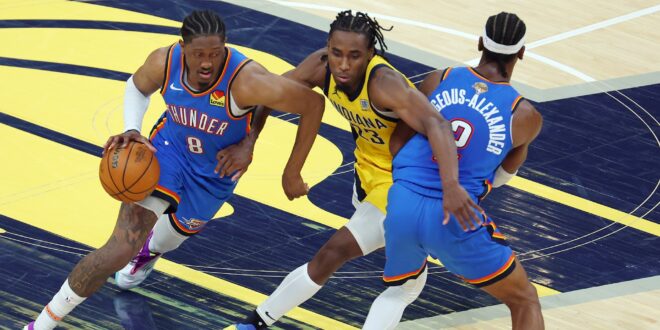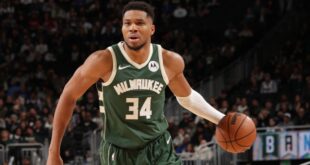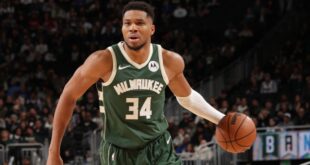In challenging circumstances, unconventional strategies are often employed. This is especially true in the high-stakes atmosphere of the NBA Finals, where teams may resort to tactics they haven’t frequently used throughout the season.
Such was the situation on Friday when the Oklahoma City Thunder pivoted with a significant tactical shift, opting for a rarely utilized maneuver that could potentially alter the course of their season. The Thunder’s two All-Stars collaborated effectively to recover from a seven-point deficit in the fourth quarter, ultimately tying the series at two games apiece with a hard-fought 111-104 win in Game 4.
Shai Gilgeous-Alexander found a favorable matchup and scored 15 of his 35 points in the critical final minutes of the game. The Thunder excelled defensively while converting 15 of their last 18 offensive possessions, outpacing the Pacers in clutch play and setting the stage for a best-of-three showdown, with two of the remaining games scheduled in Oklahoma City.
Let’s dive into some insights, statistics, and analysis of how Gilgeous-Alexander effectively managed to create separation from Andrew Nembhard, outperforming the Pacers in those crucial moments.
Initially, Gilgeous-Alexander is recognized more as a ball-handler than a screener. In the first three games of the Finals, his involvement as a screen-setter was minimal, with just two ball screens and seven off-ball screens documented by Second Spectrum. However, elite players can become highly effective screeners due to defenders’ reluctance to abandon them.
In the first quarter of Friday’s game, Gilgeous-Alexander executed what was technically his third ball screen of the series. More of a light tap than a traditional screen, it nonetheless provided Jalen Williams with the space needed to gain an advantage over Ben Sheppard. Nembhard hesitated to leave Gilgeous-Alexander, which allowed Williams to drive all the way to the basket.
Williams had a productive night, with 23 out of 27 points coming from within the paint or at the free-throw line. Over the series’ duration, the Thunder enjoyed a significant +32 advantage in the paint and +29 at the line, compared to the Pacers’ +48 outside of the painted area.
After a lull in ball-screening duty until early in the third quarter, when the Pacers switched to keep Williams from penetrating, Gilgeous-Alexander facilitated ball movement back to him. However, despite the isolated opportunity, Williams missed an open three-point attempt.
As the fourth quarter progressed and with the Thunder trailing by two, Gilgeous-Alexander initiated another subtle screen, once again allowing Williams to gain a half-step on his defender while Nembhard remained glued to the MVP.
With three possessions remaining and the Thunder down by four, Gilgeous-Alexander set a more substantial screen this time, facilitating Williams’ role while Nembhard switched defensive assignments. Showcasing an impressive side of his game, Williams took the opportunity to get to the foul line, from where Gilgeous-Alexander capitalized, earning two of his ten free throws for the night.
On the subsequent possession, they repeated their success, with another switch freeing up Gilgeous-Alexander. Nembhard quickly doubled down on Gilgeous-Alexander, but Williams maintained pressure, resulting in a successful three-pointer that narrowed the deficit to one with just under three minutes remaining.
Typically, teams achieve favorable matchups by setting ball screens with the player being guarded directly. However, leveraging the star offensive player as the screener can be equally effective. Such strategies often enabled players like Dirk Nowitzki to create mismatches, isolating opposing guards effectively.
Though Nesmith successfully defended Jalen Brunson during the conference finals, he is noticeably larger than Nembhard. In their past encounters during the regular season, Gilgeous-Alexander had success against Nembhard, scoring 45 points in a game that Nesmith missed.
In the initial three games of the Finals, the Thunder relied on a smaller starting lineup, which allowed the Pacers to assign Nesmith to Gilgeous-Alexander. However, they opted to retain Nembhard, which was evident in the crucial moments of Game 4.
After the clutch three-pointer, Gilgeous-Alexander had his chance against Nesmith in transition without needing a switch, allowing him to go one-on-one. Despite a slight misstep while maneuvering to lose Nesmith, he skillfully sank a step-back jumper to give the Thunder their first lead since the second quarter, as Nembhard was a step too late to provide help defense.
With just under a minute left and the Thunder ahead by two points, Gilgeous-Alexander set one last screen for Williams, securing another switch that allowed him to isolate against Nesmith. He attacked to the left and drew another foul while pivoting back towards the paint.
Ultimately, Nesmith fouled out, and Gilgeous-Alexander secured the Thunder’s lead with two critical free throws. Nesmith’s foul trouble speaks to the challenge he poses against the MVP.
Throughout the first three Finals games, Gilgeous-Alexander and Williams had only three ball screens between them. However, in Game 4, they collaborated on nine, marking the highest total in their three-year partnership (spanning 229 games). Their combined activity in the final minutes surpassed any prior quarter during their time together.
Confronted with the prospect of a dire series deficit, the Thunder adapted their strategy, and their willingness to innovate proved fruitful.
Anticipate more SGA-Williams connections in Game 5 on Monday (8:30 p.m. ET, ABC).
* * *
John Schuhmann serves as a senior stats analyst for NBA.com. For further inquiries, please reach out via email, explore his archive, or follow him on X.
The opinions expressed on this page do not necessarily reflect those of the NBA, its franchises, or Warner Bros. Discovery.
 NBA News NBA News, Match Reports and Updates
NBA News NBA News, Match Reports and Updates



